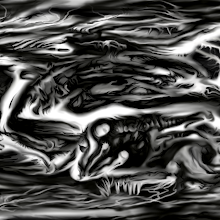OK - so in the process of mucking around to see what's killing my system, I decided a BIOS update might be a good idea - I was using A01 and they'r eup to A06 these days. One small hitch - the update comes as - you guessed it - a EXE file.
What to do? Virtualbox is a no-go, because of course the hardware that the guest see is *virtual* (duh). Make a small partition for XP? Hell no. Simlple solution - remaster a DOS boot disk with the BIOS update.
Step 1 - download your BIOS update. BE SURE THAT IT WILL OPERATE IN DOS.
Step 2 - download a DOS boot image:
http://www.bootdisks.us/ms-dos/5/ms-dos-bootable-cd-images.html
I chose DOS 6.22.
Step 3 - install isomaster (sudo aptitude install isomaster)
Step 4 - open the DOS iso in isomaster, add the BIOS update, do CTRL-S to save the new image.
Step 5 - burn the ISO to disk. Don't just copy the ISO to disk - burn an image. But you knew that already ;)
Step 6 - boot from the new CD. At the prompt, switch to the CD (drive R: if you used DOS 6.22). Run the BIOS updater. Dance around on one foot while sacrificing a chicken.
All done :) While technically you are not using Ubuntu to update the BIOS, you're not having to nstall windows either so count your blessings!
Sunday, September 20, 2009
Saturday, September 19, 2009
Lobotomy
OK - so I have some bad, bad RAM. Getting some new modules ASAP, but in the meantime, the 'memmap' kernel parameter is serving me well.
I now have this line in /boot/grub/menu.lst:
# kopt=root=UUID=[some stuff] memmap=140M$580M memmap=140M$1600M ro
I now have this line in /boot/grub/menu.lst:
# kopt=root=UUID=[some stuff] memmap=140M$580M memmap=140M$1600M ro
I've added two memmap options to the end. The pseudo-syntax is [how much][unit]$[where][unit]. So I'm sitting on 140 megs starting at 580 megs and also 140 megs starting at 1600 megs.
run 'sudo grub-update' to apply the changes after editing menu.lst. 'free -m' will now report a missing ~280MB upon reboot.
Now the laptop and I have something on common - holes in our memory ;)
Wednesday, September 16, 2009
GIMP plus Python = fun

My latest GIMP plug-in:
Palette to Image
http://registry.gimp.org/node/18629
I was looking for a quick way to dump a palette into an image - I had created a GIMP palette of Union inks (for screenprinting) and wanted a quick reference image for third parties. I could not find a built-in function, so this plugin was born: "Palette to Image".
The Python-GIMP bindings are quite good - anything found in Help->Procedure browser can be called from a plug-in. In Python, just take the procedure name, put pdb. on the front, and change dashes to underscores. For example in the browser 'gimp-image-new()' becomes 'pdb.gimp_image_new()'. Easy :)
My other python plug-ins:
Export Layers as PNG
http://registry.gimp.org/node/18440
Measure Active Path
http://registry.gimp.org/node/17235
Import Kuler (ASE) palettes
http://registry.gimp.org/node/10325
Find and Replace Text
http://registry.gimp.org/node/12212
Count tiles for a mosaic
http://registry.gimp.org/node/15080
Add Rule Of Thirds guides
http://registry.gimp.org/node/11567
Image courtesy of http://www.mahvin.com
Subscribe to:
Comments (Atom)
